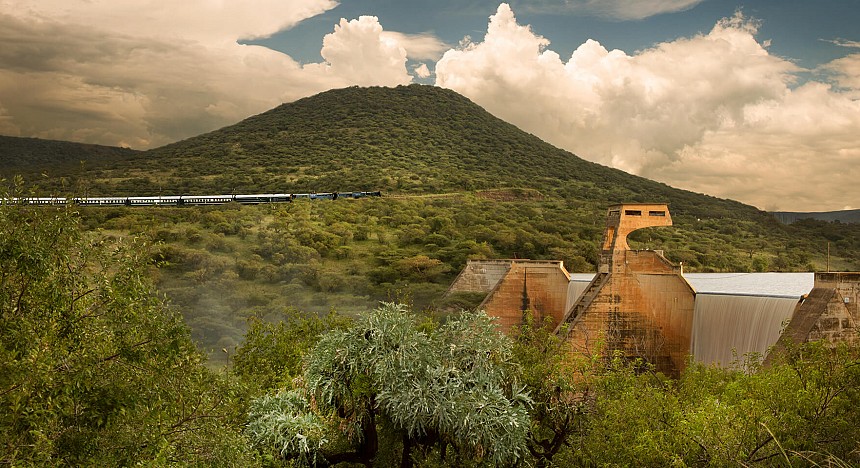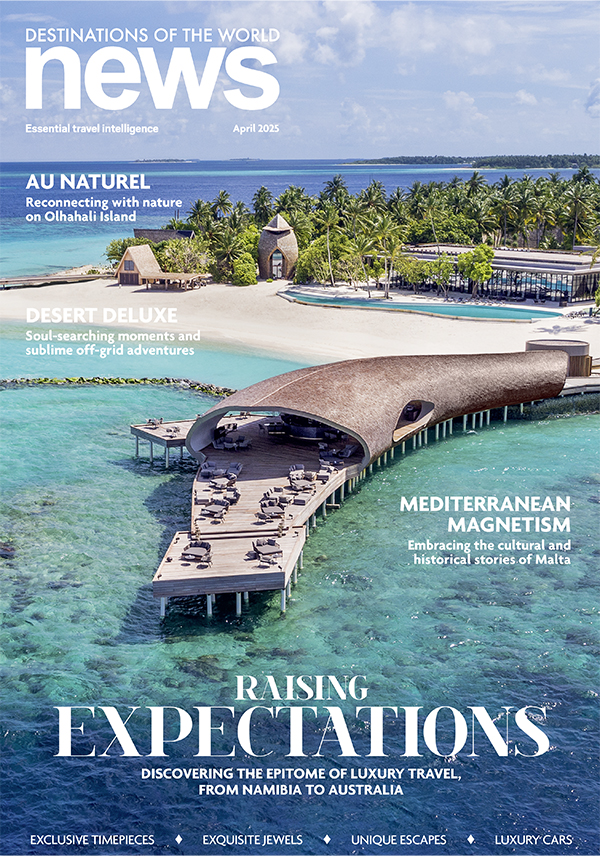The elephants are almost completely hidden by the lush vegetation. When they emerge from their green camouflage, their imposing majesty as ‘lords of the bush’ is even more fully evident. Not that the rhinoceros just metres away is any less fascinating to observe by our private group of rail enthusiasts, the only humans in view. One thing people most definitely do not want to see on safari is other people. More animals in the wild are always welcome, humans in the wild less so, but that is the beauty of a private rail journey on board South Africa’s Rovos Rail luxury train. But, I hear you ask… Safari by train? Is that even possible?

In South Africa, a land with dozens of safari lodges, it certainly is. The famed lodges all operate in the same basic manner, usually requiring domestic air transfers on tiny aircraft to reach their isolated locations. Rovos Rail removes this need, giving passengers a rolling safari experience combining the convenience of city-to-city transport with the romance of old-age train travel. And then there are the game drives, the cultural excursions, and the general gratitude for enjoying a very special double adventure.

Although Rovos Rail offers several itineraries, a taste of the Rovos Rail experience and a sampling of safaris can be experienced on a three-day, two-night journey between Durban in KwaZulu-Natal province and Pretoria in Gauteng. Leaving ocean sands behind for animal encounters is already a unique start to any safari, most of which take place inland away from urban playgrounds, such as Umhlanga Rocks, an upscale suburb of Durban where the natural beauty and serenity of the coastal walking path by day is complemented by a buzzing dining and clubbing scene at night.

Once on board the train at Durban railway station, passengers are given time to settle into their accommodation before the first off-train activity. Rovos Rail’s individual staterooms come in a variety of sizes, their walls of polished wood conveying a genteel air of comfort and exclusivity. One of the pleasures of rail travel is discovering the ingenious use of limited space to make the most of the square metres available. What is surprising on board Rovos Rail are the relatively large bathrooms, comparable in size to bathrooms in urban apartments on land, complete with full shower.


The first stop on the Durban to Pretoria route is one of South Africa’s most unusual craft workshops. There are animals in abundance at Ardmore Ceramics, but they are made of clay and painted in vivid colours. Not at all a stereotypical tourist shopping stop for the masses, Ardmore Ceramics in the Midlands above Durban has long been recognised as the country’s most acclaimed producer of ceramic art. The variety of whimsically original pieces can be attributed to the imaginative minds of the artisans themselves who are given free rein to create whatever inspires them.

This explains the besuited crocodiles, smiling monkeys, and phantasmagorical vegetation that occupy the exquisite showroom. There are no tatty trinkets here; prices for some of the more elaborate items can reach into tens of thousands of dollars but devoted clients are happy to pay for the uniqueness and high quality of the one-of-a-kind pieces. It is possible to observe the artisans in their workshop spaces, an experience which serves to appreciate the know-how and craftsmanship required to create such intricate works.

While free rein is given to the employees at Ardmore, the same cannot be said for the beautiful horses who live in the adjacent stable. The owners of Ardmore Ceramics are avid equestrians; some members of the family compete at world competitions astride the prized mares, stallions, and geldings stabled here with great care and attention.
Back on board the train, after some time to rest in the stateroom or perhaps in the open-air observation car, dinner is served in a dining car adorned in white linen, fine china, and lots of forks, knives, and spoons. Although the general selection can be somewhat limited, the quality of the food and service is very high. Specific dietary requirements and preferences can be accommodated with advance notice; the chef is happy to make people happy and so are the servers. Indeed, it is the commitment to excellence on the part of Rovos Rail’s staff that is one of the highlights of the trip. The adjacent lounge car is at its liveliest after dinner when the quiet library atmosphere of the day is replaced with the buzz of socialising, as guests engage in animated conversation.

Having had the warm-up act on the first day, the second brings the main event with not one but two game drives in two different private reserves. Unlike national parks in South Africa, the private reserves are indeed private and therefore the management can restrict the number of visitors at any given time. When Rovos Rail arrives, there are no other visitors to the reserves. This alone is exceptional; images of safari vehicles packed with tourists too close to the animals are all over the internet as more and more people seek to interact with nature, ironically causing disruption to the nature they come to see.

At Spioenkop Lodge, there are only the few vehicles for Rovos Rail passengers on the 11,000-acre reserve. The vehicles head off in different directions so that there is only ever one vehicle at a time in each area of the reserve. The absence of apex feline predators in the reserve does not detract from the awe inspired by the animals that do inhabit the land. Giraffes, elephants, rhinoceroses, and water buffalo all count among the largest, but even tiny insects different from what are known at home are cause for education and amusement.

After lunch at Spioenkop, the second game drive takes place in Nambiti Reserve, a parcel of land over 20,000 acres in size with a diversity of ecosystems that includes savannah grassland and undulating hills. Some passengers opt for a presentation on the tumultuous colonial history of the region in lieu of a second game drive in the assumption that one game drive is just like another. Not true. A different landscape with different vegetation provides a different experience from the morning drive at Spioenkop.

Arrival in Pretoria is more of an occasion than was the departure from Durban. Unlike in Durban, where the train departs from the city’s main station, Rovos Rail maintains its own private railway station in Pretoria in a quiet location that seems worlds away from the urban hubbub beyond the gates. There is a small museum at the station, a nice touch to enhance appreciation of the Rovos Rail experience. Of course, the staff will have already arranged onward transfers to the airport or to hotels.

Those guests staying in Pretoria will be pleased with The Rasmus, a mansion turned guesthouse on a working farm within the city limits. Why let unusual experiences with animals end with a rail experience? Set on 50 acres of property, The Rasmus has only nine rooms, making it perfect for a full buyout for family or friends seeking privacy and discretion while having a service staff available on site. At The Rasmus, elephants, giraffes, and zebra are replaced with cows, goats, and sheep, but banish any images of barns and tractors; the manicured grounds of The Rasmus are beautifully landscaped, evoking the feeling of a private park – exactly what it is. Food served at The Rasmus is produced on the farm to the fullest extent possible, meaning guests enjoy only the freshest of food here. There are fish, too, but they are in residence for aesthetic purposes rather than culinary. The large koi occupying the pond that welcomes guests to The Rasmus are echoed in decorative touches throughout the property, including even the wallpaper.

Travellers seeking accommodation on larger premises with a wider array of facilities can enjoy a stay at the splendid Four Seasons The Westcliff in Johannesburg, easily reached from Pretoria by transfer with Ulysses Tours, a reliable transport company with friendly drivers. Aside from the luxurious rooms and suites, the phenomenal cuisine served on a terrace with sweeping views, and a spa area that brings serenity to even the most frenetic mind. Johannesburg’s booming culinary scene is attracting global attention right now and nowhere is a drink or dining experience more satisfying than on the airy terrace of Flames, Four Seasons’ chic restaurant where South Africa’s glitterati come for the leafy panorama, tasty libations, exceptional food, and glamorous ambience. The 80 rooms and suites of Four Seasons The Westcliff, built in multiple clusters rather than in a single building, were originally planned as a residential community and thus have the intimate feel of a small Mediterranean village, a notion further enhanced by the garden areas found throughout the property.


It is worthwhile to arrive in Durban several days before a Rovos Rail departure to gift yourself time to take in the sights of this underrated city, one that is a little off-the-beaten-path for international travellers despite its popularity as a holiday destination for South Africans. The fascinating but little-known Campbell Collections are located in a grand old Dutch-style mansion housing a series of artworks depicting various South African tribal customs in vivid detail. The very hip KwaZulu Natal Society of Arts showcases contemporary South African art in an architecturally interesting modern building.


Durban City Hall is a magnificent, British-era edifice and the Botanic Garden is also perfect for travellers who enjoy greenery in abundance. The visual presentations at the Kwa Muhle Museum explain the development of apartheid, the horrendous policy cruelly enforced first in Durban before spreading across the country. It is rather shocking to confront but unexpectedly uplifting to know that this period is South African history is now in the past. In addition to the Umhlanga Rocks north of the city centre, Florida Road is another location for good restaurants and high-end boutiques, especially those selling decorative items and furniture for the home.

Often overlooked is Durban’s connection to railway history thanks to a long-time South African resident, a certain man named Mahatma Gandhi. It was from a train that departed Durban that Mahatma Gandhi was unceremoniously challenged for riding in First Class despite having purchased a First-Class ticket. He was thrown off at the next stop, Pietermaritzburg, where today there is a statue commemorating the incident that was the impetus for his nonviolent resistance movement that changed the history of South Africa, India, and other places in the world. The Mahatma Gandhi house located on a gated property in Durban’s Phoenix Settlement township displays several informative exhibits related to his life in South Africa. Thankfully, it would be different today.
Stay:
Rovos Rail
Four Seasons Hotel The Westcliff
The Rasmus






